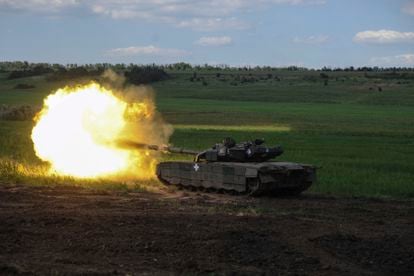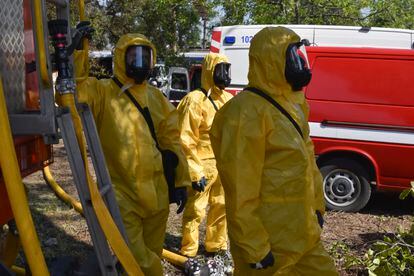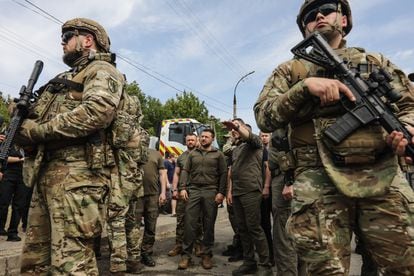
Ukraine consolidates counteroffensive with attacks in Zaporizhzhia
The southern region, 80% of which is controlled by Moscow, is the strategic point where Kyiv is trying to break the corridor which connects the Crimean peninsula with the Donbas for Russians
In an operation that could run for weeks or even months, Ukraine is trying to make a dent in the territory gained by the Russian army following the major invasion launched in February of last year. Clashes between local troops and Russian invaders in the southeast of the country have intensified in recent hours, particularly in the region of Zaporizhzhia, according to anonymous Ukrainian and Western testimonies, in a sign that the expected Ukrainian counteroffensive is consolidating. The first signs of the long-awaited military operation were recorded on Monday.
The setting for this new battle is Zaporizhzhia, the strategic region where Ukraine is trying to break the corridor that allows Russia to connect the Crimean peninsula, illegally annexed in 2014, with the Donbas (the territory which includes the occupied regions of Donetsk and Lugansk). Zaporizhzhia is also home to Europe’s largest nuclear power plant, occupied by Russian forces since March 2022. There are indications that German-made Leopard tanks which Kyiv has received from different European countries are already fighting there, according to some images circulating on social media and according to Russian military sources. Meanwhile, Ukraine claims that it continues to advance on enemy positions in Bakhmut (Donetsk region), a town that Russia almost completely controls since May, after long months of fierce fighting.
Some of the confirmations of the large military operation have even come from President Volodymyr Zelenskiy’s entourage, according to the U.S. network ABC, although the president himself has kept silent in public in order to not hinder the campaign. One of the latest developments has taken place around the city of Orijiv, Deputy Defense Minister Hanna Maliar said on Telegram. Zelenskiy had already acknowledged at the end of May in an interview with The Wall Street Journal that they had everything ready for the counteroffensive. The government and the army insisted that the operation would not be officially and publicly launched, but, at the same time, they have not failed to offer hints about its imminence over the last few weeks.
The Russian command itself has also acknowledged that Ukraine has launched a serious attack in the last hours in Zaporizhzhia, a region 80% controlled by Moscow, but, according to the Russian Minister of Defense, Serguei Shoigu, they have managed to repel it, causing “serious casualties” among the 1,500 Ukrainian troops. Three of the Leopard tanks were destroyed, according to Russian military sources quoted by Reuters. In another sign that this new phase in the war has already begun, the British Ministry of Defense noted in its daily report that the local army has taken the initiative on the battlefield. Two U.S. media outlets, ABC and The Washington Post, reported that the counteroffensive had begun on Thursday, although local authorities continue to refuse to offer any confirmation. A senior U.S. official told The New York Times that fighting has intensified in the southeast. In the face of this official silence, even local Ukrainian media are quoting foreign media.

Members of the Ukrainian emergency services carrying out a drill on Wednesday in Zaporizhia, in the area under Kyiv's control.ANDRIY ANDRIYENKO (AP)
Top military officers have also spoken out. “The time has come to take back what is ours,” a video published by the head of the Armed Forces, General Valerii Zaluzhnyi, said on May 27, giving his blessing to the great operation to retake lost ground. “Our heroic soldiers are going on the offensive to liberate Ukraine from Russian occupiers and raise the banner of victory,” added the announcement, laced with military epic and inspired by the century-old work of local author Osip Mashchak.
These developments suggest that this week’s bursting of the Nova Kakhovka dam on the Dnipro river and the flooding of dozens of villages in the Kherson region were not enough to significantly alter the plans that Kyiv had been cooking up for months. Some analysts, without concluding precisely that it was the Russians who blew up the dam, nevertheless consider that it could have been a strategy to try to prevent the Ukrainian advance, as the Institute for the Study of War (ISW) has shown.
On the ground, the water has forced a Russian withdrawal to positions from where it is difficult to continue attacking Ukrainian positions on the western side of the river with its artillery, which it had been shelling almost daily. This has forced them to move five to 15 kilometers beyond the flooded areas, according to the spokeswoman for the Armed Forces Southern Command, Natalia Humeniuk. Two-thirds of the flooded area is under Russian control, according to local authorities in Kherson.
Zelenskiy’s visit
Without referring to aspects directly related to the counteroffensive, President Zelenskiy went to the area on Thursday to closely follow the rescue work and keep up-to-date with the consequences. The Kremlin announced that President Vladimir Putin has no plans to travel to the flooded localities under the control of his military. Attacks are continuing from the Russian side on the western bank of the Dnipro while Ukrainian emergency teams are carrying out rescue work.

Volodymyr Zelenskiy on Thursday in Kherson.MYKOLA TYMCHENKO (EFE)
In total, nine people have been injured, including two members of the rescue services, according to sources from that body and the governor of Kherson. The pro-Russian authorities in power on the eastern side of the river accused Ukraine of also launching attacks that killed two people. Five others were reportedly killed by the floods.
Having overcome the major obstacle in the first weeks of the invasion, which was to stop the Kremlin troops in their attempt to seize Kyiv, the local army has since carried out two successful counter-offensives. One, last September, enabled it to recapture almost the entire Kharkov region in the northeast. Another, in November, made it possible to expel the Russians from the western bank of the Dnipro river and to liberate the city of Kherson, the only provincial capital which had been seized in the full-scale invasion launched on February 24 last year.


No comments:
Post a Comment